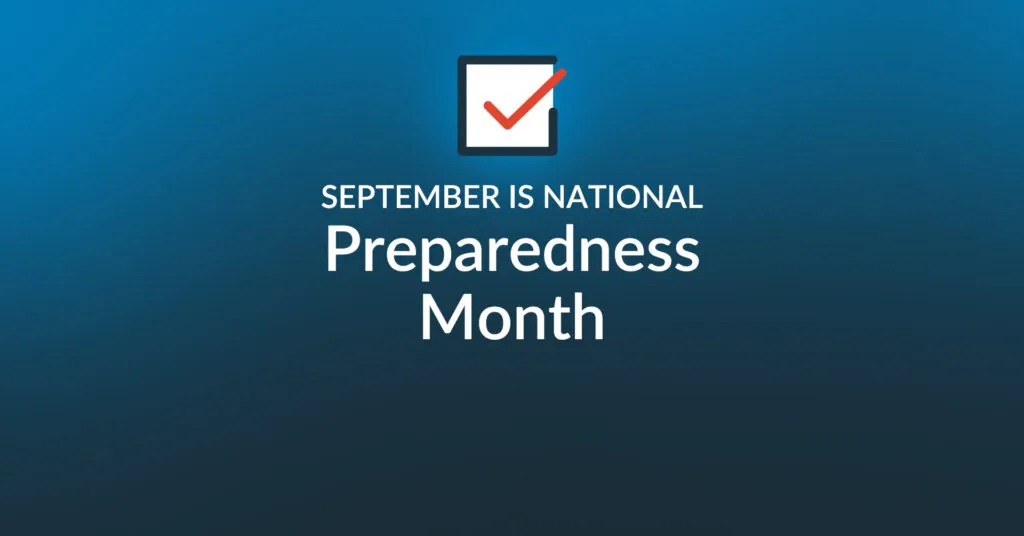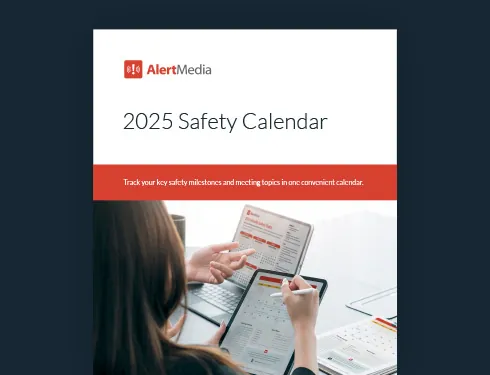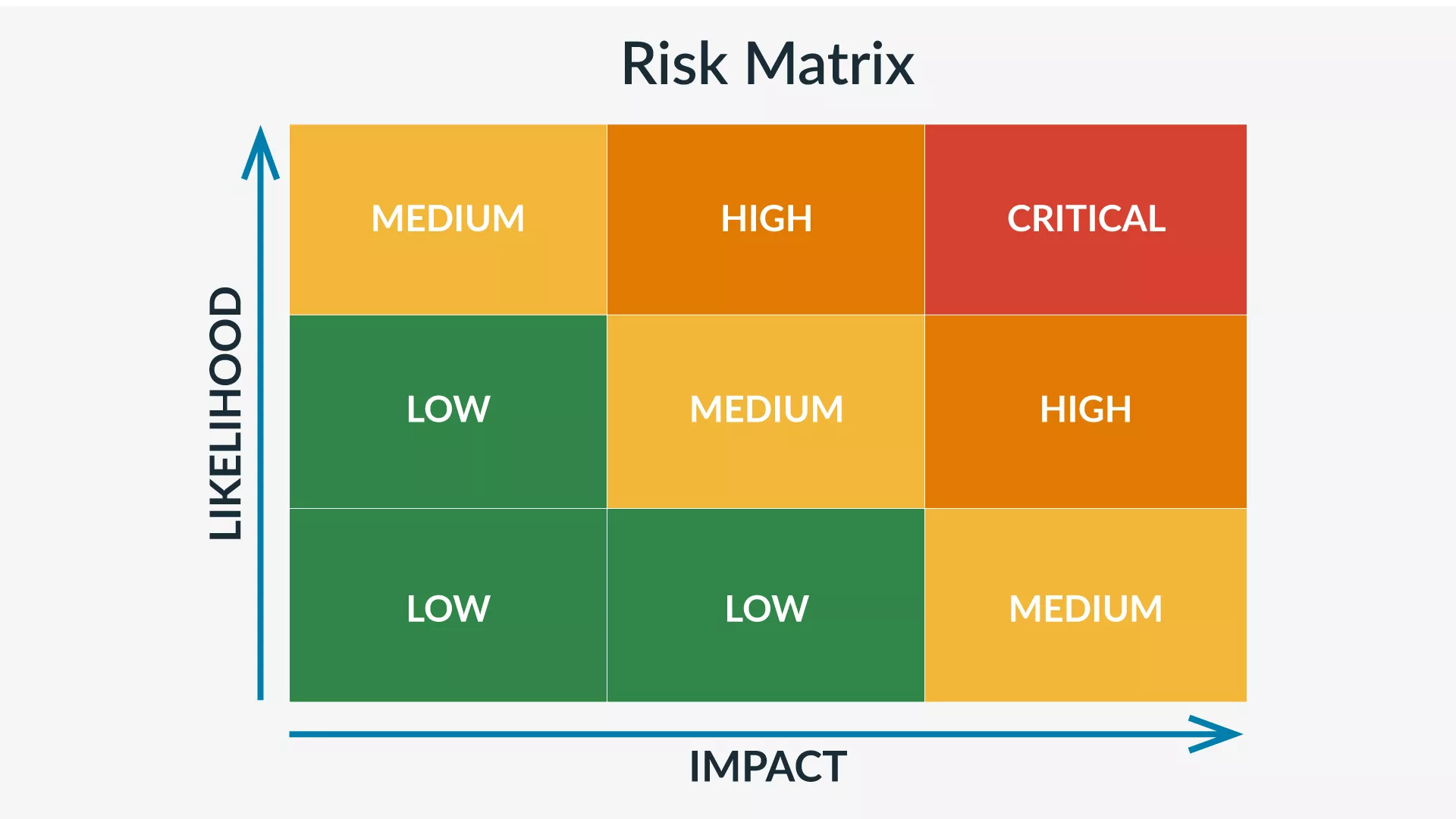
National Preparedness Month—Build a Plan for 2024–2025
September is National Preparedness Month, the perfect time to take a step back and reassess your organization’s emergency preparedness plans.
Need some help getting started? We’ve got you covered.

Emergency and disaster preparedness goes beyond issues of convenience—for households and businesses. Because the risks to life and operational continuity are so high, preparedness is a year-round priority. But we can benefit from this awareness month for several reasons:
- This is a set time on the calendar for creating and updating emergency plans
- It’s a time when national attention turns to issues of community preparedness
- It’s a time to reassess safety trends and reprioritize risk mitigation
- And it’s a time to recommit to your people’s safety and well-being, as well as your company’s lasting legacy
Since 2004, September has been designated National Preparedness Month—a time when businesses, individuals, and communities are encouraged to evaluate and improve their response readiness for emergencies and disasters.
As the last several years have revealed, year-round challenges require constant vigilance to maintain a safe and thriving business. Severe weather events, natural disasters, acts of violence, and public health crises have kept us on our toes and reminded us of the value of advance preparation. After all, the time when you are least capable of creating and fine-tuning safety plans is in the midst of an actual crisis.
There are several ways to participate in National Preparedness Month and apply best practices to both your professional and personal life.
Don’t know where or how to start? You’ve come to the right place!
What Is National Preparedness Month?
Ever since the terrorist attacks on September 11, 2001, the United States Government has increased its focus on educating its citizens on how to stay safe during emergencies. In memory of that tragic day, the Federal Emergency Management Agency (FEMA) and the Department of Homeland Security have dubbed September “National Preparedness Month” or NPM. Every September, Americans are encouraged to review their emergency response plans, training, tools, and more to prepare for when disaster strikes.
The U.S. government’s hub for all preparedness info, Ready.gov, curates a theme each year to help rally and focus our preparedness efforts. For 2024, the month will focus on how Asian American, Native Hawaiian, and Pacific Islander communities can prepare for disasters and build resilience.
Preparing Asian American, Native Hawaiian and Pacific Islander Communities for Risks and Disasters in 2024
This year, in honor of the recent addition of Asian American, Native Hawaiian, and Pacific Island Heritage month in May, the theme for National Preparedness Month focuses on empowering these communities to prepare for potential disasters before they strike. .
“The Asian American, Native Hawaiian and Pacific Islander community is a large, diverse group that spans across many cultures, languages and unique circumstances that must be considered when developing strategies to engage communities on disaster preparedness,” said Administrator Criswell, FEMA Administrator in a press release announcing the theme.
It’s critical to make sure you are accounting for everyone when preparing for a disaster, even communities that may encounter barriers in the process. In FEMA’s 2023 National Household Survey, 65% of the Asian Americans and 58% of Native Hawaiian or Pacific Islanders surveyed reported that they don’t believe that taking a step to prepare will make a difference and that they were not confident in their ability to prepare. This gap shows there is more work to be done, especially in areas like Hawaii and Guam, where hurricanes, fires, and other natural disasters have a significant impact.
This month, consider how you will take extra steps to include Asian American, Native Hawaiian, and Pacific Islander communities in your preparedness and disaster response planning, so everyone has a better chance of staying safe during a crisis.
6 Steps to Effective Emergency Preparedness
In truth, every month is preparedness month. But now is the perfect time to kick off a system of preparedness—a system that is sustainable, iterative, and adaptable to changing risks.
Follow along with this National Preparedness Month calendar to plan out a productive month. And if you want to integrate safety planning all year long, you can download this free annual Safety Calendar.

1. Determine the threats to your organization
The initial step of emergency management sets the foundation for all of your efforts to follow. You first need to conduct a business threat assessment. With this method, you identify the risks your business might face and analyze the likelihood and impact of those various risks. Then, with these clues in hand, you can approach planning and preparation steps according to the highest priorities.
Think about the things that could throw a wrench in your operations or threaten your people:
- What happens if you can’t come to the office anymore?
- What if your facility loses power for an extended period of time?
- What if one of your key suppliers or customers can’t get to you because of record-breaking wildfires?
To capture all of these concerns, build your threat assessment team thoughtfully. Engage diverse employees to help cover your bases: Key stakeholders in HR, facilities management, IT, business continuity/disaster recovery departments, and others can offer their expertise to predict threats. Executives can help champion the group’s initiatives and ensure company-wide adoption.
PRO TIP: Another way to identify present threats is to use a threat intelligence system. These platforms draw on a variety of sources, from local news and EMS to analyst-vetted reports, and can notify you of critical events as quickly as possible. You can also set them up to automatically notify you or a specific group of people should a certain event occur.
Together, consider the wide variety of risks and hazards your people and the business potentially face. Then, prioritize those risks by impact and likelihood. For example, a company might face two potential threats: the meltdown of a nearby nuclear reactor and icy roads that threaten their delivery trucks in the winter. Of course, a reactor meltdown would be a massive risk to everyone nearby, but those events are rare. Severe weather events, however, might be a common dilemma for the business, even if the impact is lower per event. How do you effectively plan for these possibilities? One way is by quantifying these threats across a threat matrix. By doing so, your threat assessment team can decide how best to prepare for these problems.

2. Develop an emergency plan
Now that you’ve mobilized your safety squad and identified potential threats across your business, it’s time to document your emergency response plan. This document will be the single source of truth for everyone who might be affected. It should include the ideas you already outlined in your risk assessment and delegate roles to appropriate stakeholders so everyone knows who has to do what in an emergency.
When you sit down to write your plan, think through what each threat could mean to your business and your people and how best to handle it. Consider ways you can prevent these risks, as well as ways you can respond to them. Sometimes there’s nothing you can do to prevent an emergency. You might not be able to stop the snow from falling and the ice from crusting the roads, but you can make sure your employees receive timely emergency alerts, they are empowered to work remotely, and any traveling workers are aware of the dangerous conditions and supporting in finding shelter if needed.
On the other hand, there are things that you might be able to lessen the likelihood of, such as the spread of a virus during a pandemic. In such a scenario, building your plan around communicating with employees about known viral exposures and performing contact tracing can lessen the number of people who become infected, saving you downtime from sick employees.
Whatever you describe in your plan, it should be a living document. As your business grows and your environment changes, be sure to revisit your emergency response plan and update it regularly. Reconvene your safety stakeholders regularly to revise and expand emergency response procedures.
3. Build and maintain resource kits
Now it’s time to go beyond the written plans and create disaster preparedness kits. These are the resources and supplies you may need to access at a moment’s notice. Note that these kits will be situation specific, such as for power outages or earthquakes—and they will differ from the list of survival materials included in personal disaster kits.
To create an emergency kit, put yourself in the shoes of the designated emergency manager during your emergency of choice. What scenarios should you focus on in the first place? What would you need at a glance to fulfill your duties? These things will likely include communication templates to ensure rapid and accurate messaging; evacuation plans to ensure everyone can get out safely; and contact information for key emergency stakeholders.
Along with your emergency response plans, you’ll need to update your kits for different threats on a regular basis. For seasonal emergencies like wildfires or hurricanes, once per year is a good time to update, but for perennial threats like workplace violence or power outages, you must revisit your resource kits every few months to ensure they keep up with any internal and external changes.
Ready.gov has excellent resources to assist you in curating your own emergency kit. AlertMedia also has several free kits to help with threat assessment, communication, and response planning.
4. Run drills and exercises
Now that you have your comprehensive emergency response plan and a good idea of how everyone fits into the puzzle, it’s time to put it to the test and uncover any issues. Some of the most widely employed of all training exercises are fire drills. Another popular method for testing emergency plans is through tabletop exercises, or TTXs, where those plans are effectively acted out in a stress-free environment. Everyone has a chance to practice their duties without pressure or risk. In this way, you can identify errors and holes in your plans, and people can raise questions likely to help the whole group.
Emergency drills play an important role in emergency preparedness, especially for the government, military, healthcare fields, and charities like the American Red Cross. By exposing your people to a simulated version of the emergency scenario in question, you can take note of and fix any problems that arise. As JoAnn Dankert, Senior Safety Consultant at the National Safety Council, said during an episode of The Employee Safety Podcast, “The idea behind [a] drill is not just so people are ready, but to also uncover any sort of gaps or glitches that an organization might have and then that gives you the chance to put corrective actions in place… in a safe environment and at the pace you would like to.”
5. Enhance communication
During an emergency, the most valuable resource is information. People need to know if they’re safe, when it’s time to evacuate, if they can come to work, etc. And they need answers quickly. As part of National Preparedness Month activities, first and foremost, ensure that employee contact information is continuously updated so nobody is left in the dark.
Use templates
Secondly, you need to know what to communicate to support response efforts in specific instances. Assuming you’ve identified potential threats, you can create communication templates ahead of time so you’re not trying to compose messages with critical information on the spot during incredibly stressful times.
Find a reliable system
Finally, you need a reliable communication channel you can use to reach your employees. An entire industry centered on mass communication technology has flourished in the past decades. The days of phone trees are long gone. We now live in an era where users can send messages via emergency notification systems that offer advanced two-way messaging; targeted, reliable delivery; and instant reporting.
Build trust
Beyond simply distributing information, robust communication practices can improve morale and help buoy employees during hard times. When information is scarce and your people feel uneasy, knowing that they can rely on their company to keep them informed goes a long way to show them that you truly care about their safety. If they’re able to count on you as a trusted source of information, they’ll be less likely to believe misinformation spread via social media and will be more likely to engage with recovery efforts.
6. Prepare Beyond the Workplace
We’ve spent a lot of time talking about emergency preparedness in the context of businesses and other organizations. But National Preparedness Month is also a time to prepare and protect those closest to us.
If you can integrate employees’ families into your preparedness plans, you’ll not only support the emotional and physical well-being of your people, but you’ll also demonstrate that preparedness doesn’t begin and end at the company’s doors.
Enable your employees to spend time developing personal emergency action plans for their families. Point toward resources that can help them assemble emergency and first aid kits, as well as formulate evacuation plans for family members and pets. During a disaster, communication is as important for families as it is for businesses and large organizations. Assist your people in building personal communication plans so they know how to get help. Once again, FEMA provides detailed advice on how best to do so with your children, loved ones, and communities.
AlertMedia Can Help Cover Your Bases
This September, take the initiative to evaluate your level of emergency preparedness and the plans you have in place to track and respond to any and all threats. Whether you’re focused on mitigating the effects of natural disasters or managing a now-remote workforce, the right planning can make all the difference. Download the Annual Safety Calendar to keep track of your emergency planning and preparedness initiatives all year long.





